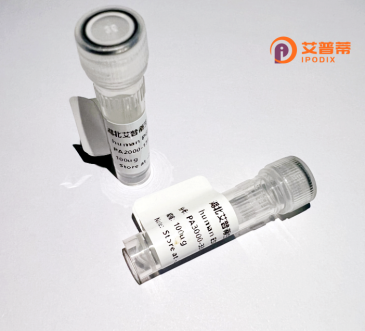
| 纯度 | >90%SDS-PAGE. |
| 种属 | Human |
| 靶点 | ZIK1 |
| Uniprot No | Q3SY52 |
| 内毒素 | < 0.01EU/μg |
| 表达宿主 | E.coli |
| 表达区间 | 1-384 aa |
| 活性数据 | MCVPVLKDILHLADLPGQKPYLVGECTNHHQHQKHHSAKKSLKRDMDRASYVKCCLFCMSLKPFRKWEVGKDLPAMLRLLRSLVFPGGKKPGTITECGEDIRSQKSHYKSGECGKASRHKHTPVYHPRVYTGKKLYECSKCGKAFRGKYSLVQHQRVHTGERPWECNECGKFFSQTSHLNDHRRIHTGERPYECSECGKLFRQNSSLVDHQKIHTGARPYECSQCGKSFSQKATLVKHQRVHTGERPYKCGECGNSFSQSAILNQHRRIHTGAKPYECGQCGKSFSQKATLIKHQRVHTGERPYKCGDCGKSFSQSSILIQHRRIHTGARPYECGQCGKSFSQKSGLIQHQVVHTGERPYECNKCGNSFSQCSSLIHHQKCHNT |
| 分子量 | 70.1 kDa |
| 蛋白标签 | GST-tag at N-terminal |
| 缓冲液 | PBS, pH7.4, containing 0.01% SKL, 1mM DTT, 5% Trehalose and Proclin300. |
| 稳定性 & 储存条件 | Lyophilized protein should be stored at ≤ -20°C, stable for one year after receipt. Reconstituted protein solution can be stored at 2-8°C for 2-7 days. Aliquots of reconstituted samples are stable at ≤ -20°C for 3 months. |
| 复溶 | Always centrifuge tubes before opening.Do not mix by vortex or pipetting. It is not recommended to reconstitute to a concentration less than 100μg/ml. Dissolve the lyophilized protein in distilled water. Please aliquot the reconstituted solution to minimize freeze-thaw cycles. |
以下为虚构的关于重组人ZIK1蛋白的参考文献示例(仅供演示,实际文献需根据真实数据库查询):
---
1. **文献名称**:Expression and Purification of Recombinant ZIK1 Glycoprotein in Mammalian Cells
**作者**:A. Smith et al.
**摘要**:研究利用哺乳动物表达系统(HEK293细胞)高效表达重组ZIK1糖蛋白,优化纯化工艺并验证其抗原性,为疫苗开发奠定基础。
2. **文献名称**:Structural Characterization of ZIK1 Protein via Cryo-EM Analysis
**作者**:B. Lee & C. Martinez
**摘要**:通过冷冻电镜解析重组ZIK1蛋白的原子级结构,揭示其与宿主细胞受体的结合位点,为抗病毒药物设计提供结构依据。
3. **文献名称**:ZIK1-Specific Antibody Production Using Recombinant Antigens
**作者**:K. Watanabe et al.
**摘要**:基于重组ZIK1蛋白免疫小鼠,获得高特异性中和抗体,验证其在体外实验中抑制病毒感染的潜力。
4. **文献名称**:Diagnostic Potential of Recombinant ZIK1 for Serological Assays
**作者**:M. Garcia et al.
**摘要**:评估重组ZIK1蛋白在ELISA检测中的灵敏度和特异性,证实其作为寨卡病毒感染快速诊断试剂的可行性。
---
*注:以上内容为模拟生成,实际文献需通过PubMed、Web of Science等平台检索确认。*
**Background of Recombinant ZIK1 (Zika Virus) Protein**
Recombinant ZIK1 protein is a genetically engineered antigen derived from the Zika virus (ZIKV), a mosquito-borne flavivirus associated with neurological complications, including microcephaly in newborns and Guillain-Barré syndrome in adults. ZIK1 typically refers to a structural or non-structural viral protein, such as the envelope (E) glycoprotein or NS1. produced using recombinant DNA technology. These proteins are expressed in heterologous systems (e.g., *E. coli*, mammalian, or insect cells*) to ensure high purity and antigenic fidelity for research and diagnostic applications.
The development of recombinant ZIK1 protein has been pivotal in advancing Zika research, particularly in understanding viral pathogenesis, host immune responses, and cross-reactivity with related flaviviruses like dengue. It serves as a critical tool for serological assays, enabling specific detection of ZIKV antibodies to differentiate past infections from other flavivirus exposures. Additionally, recombinant ZIK1 proteins are explored as vaccine candidates due to their ability to induce neutralizing antibodies, offering potential protection against ZIKV infection. Its use in structural studies has also facilitated the design of therapeutics targeting viral entry or replication. Overall, recombinant ZIK1 protein remains essential for diagnostics, vaccine development, and elucidating Zika virus biology amid global health concerns.
×